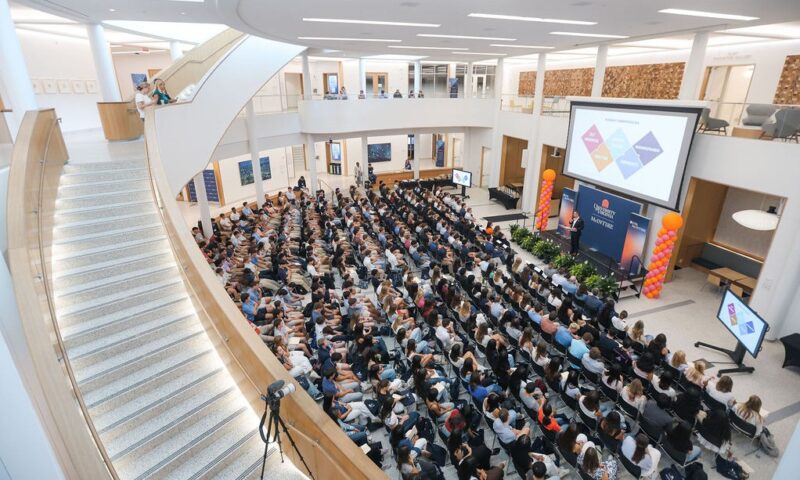Digital platforms may fall in and out of vogue, yet despite the fact that new ones are born seemingly every day, they’ve become a staple of our rapidly evolving world. Understanding the effectiveness and impact of digital channels like social media has become critical for commercial firms seeking to impactfully market their products, services, and brands.
Students looking to positively impact their skills have been learning how with McIntire’s Professor Nicole Montgomery’s undergraduate and graduate versions of her Digital Strategy course. By providing students with invaluable knowledge, they’re prepared to smartly navigate marketing that increasingly takes place on screens. Since spring 2015, Montgomery has been at the forefront of this continually changing landscape, constantly updating her course content to incorporate broader aspects of digital strategy and analytics.
The course, a critical exploration of how firms can integrate digital channels into their marketing campaigns, focuses on understanding digital platforms to create value to consumers, managers, and corporate stakeholders. Students analyze various social media and search marketing platforms, leveraging insights gleaned from data to develop their own recommendations.
Conducting Research, Making Data-Driven Recommendations
One of the first major assignments in Digital Strategy is the McIntire Social Media Campaign Project, which challenges students to conduct deep dives into consumer research and create strategic, data-driven content to share with their classmates. Reviewing recent months of posts on two social media platforms, Instagram and Facebook, students analyze the posts and the data before taking next steps.
“This project gives students hands-on experience in social media marketing, analytics, and content creation—essential skills in today’s marketing landscape,” says Montgomery. “It fosters a strategic mindset and helps students translate insights into actionable recommendations. Ultimately, it provides a glimpse into the fast-paced world of digital marketing, preparing them to make data-driven decisions and adapt to evolving industry trends.”
Taylor Lamb (McIntire ’25) highlights the project’s role in uncovering pivotal insights, noting how her team poured over links; photos; reels; and data on posts including shares, reach, comments, likes, click-throughs, while comparing metrics and tailored strategies for each platform.
Her team also engaged in customer research, leaning on lessons from Professor David Mick’s Marketing Research course the previous year. “We did a 10-question survey of 31 prospective, current, and former McIntire students,” shares the Midlothian, VA, native concentrating in IT and Marketing. “Professor Montgomery makes sure that we ask relevant questions that could lead to specific and actionable insights.”
Connor Jearls (McIntire ’25) emphasizes the analytical depth that the project required. “Creative analytics involved not just looking at a post, but specific attributes within it—color, music, everything up to the logo placement—and how all of those individual attributes affect the potential quality and engagement of a social media post,” says the Marketing and Management concentrator. Reviewing those details on detailed performance data provided the student groups with a solid analytical foundation to help them build strategic content.
Adding insight about the platform demographics, Katherine Jones (A&S ’24, M.S. in Commerce ’25) says, “We noticed that Instagram audiences were younger than Facebook audiences,” with the former drawing a more college-age crowd and Facebook users skewing toward the late 20s-early 30s age group.
“This information was useful because we could direct content towards different demographics,” Jones says, explaining that younger people tended to engage more with trending topics, such as a post about Montgomery’s contributions to an article about baby hippo social media star Moo Deng that performed well on Instagram, but less so on Facebook. “It was different than a personal story post: It showed that the younger demographic is interested in seeing McIntire’s pulse [on trending topics].”
Avery Sutro (A&S ’24, M.S. in Commerce ’25), a Biology graduate who pivoted to Commerce, agrees with Jones about the engagement trends identified through the project: “We found that even though it is a business school, posting trendier, funnier stuff that’s elsewhere on the internet really helps with engagement and getting people to interact, view, and follow McIntire,” she says, highlighting how initial insights set the stage for creative strategy development.
Group Dynamics and Collaborative Learning
Like much of the Commerce School’s pedagogy, collaboration stands central to the successful execution of the McIntire Social Media Project. “Initially, we worked together on data analysis before splitting specific tasks—one member took on design while I focused on metrics. This division maximized our efficiency,” Lamb says, illustrating how working together effectively fostered comprehensive project outcomes.
Jearls speaks to the strength of leveraging group skills. “Two of us took on the analytics in data-crunching roles and found much of the insights. And then we gave the other three people in our group the data, and they brought it all together for our final overall project,” he says, underscoring the importance of recognizing and utilizing team strengths.
The collaborative spirit in decision-making was notable for Jones. “It’s nice to be on a team with several ideas to work off of and to seriously consider before shutting any down,” she says. “Working in a group has been a great lesson in having a more open mindset, since any decision we made was based on the data to see what works without taking it personally.”
Sutro valued learning from peer presentations. “The diverse approaches taken by classmates enriched my understanding of platform-specific best practices,” she notes, emphasizing the collaborative knowledge exchange fostered by the project.
Montgomery Makes the Difference
In the McIntire Social Media project—and throughout the course—students say Montgomery’s support and innovative instructional style play a pivotal role.
Lamb values her input during small group interactions, stating, “She makes sure to come to the different groups to answer our questions and hear what we’re discussing to learn about what we’re thinking.” She also says Montgomery is an impactful teacher whose classroom is overwhelmingly positive. “She’s very joyful, clear, and engaged, and it just makes me excited to learn what she’s talking about.”
Jearls appreciates Montgomery’s commitment to his success and that of his peers. “She cares for all of her students, and she’s really passionate about the subject. She loves what she does, which brings out that positivity in the rest of the class.” he says.
Sutro admires Montgomery’s facilitation of engaging discussions on hot-button issues that never have simple answers. “She picks great topics for us to talk about, sometimes very controversial ones with a lot of gray area: Nothing’s ever black and white. Her positive energy and choice of discussion topics, like AI influencers, make for a compelling learning environment,” she says, attesting to Montgomery’s ability to make complex, difficult topics accessible.
“Professor Montgomery is always very refreshing,” says Jones. “I have her first thing Monday mornings, and she doesn’t shy away from current events. She draws on what is going on in the news and connects it to what we’re learning in class.
And when she’s able to remind us of how relevant what we’re learning is, people are more engaged and willing to have frank conversations, balancing structure with being flexible enough so that class is engaging, relevant, and still a great learning environment.”



